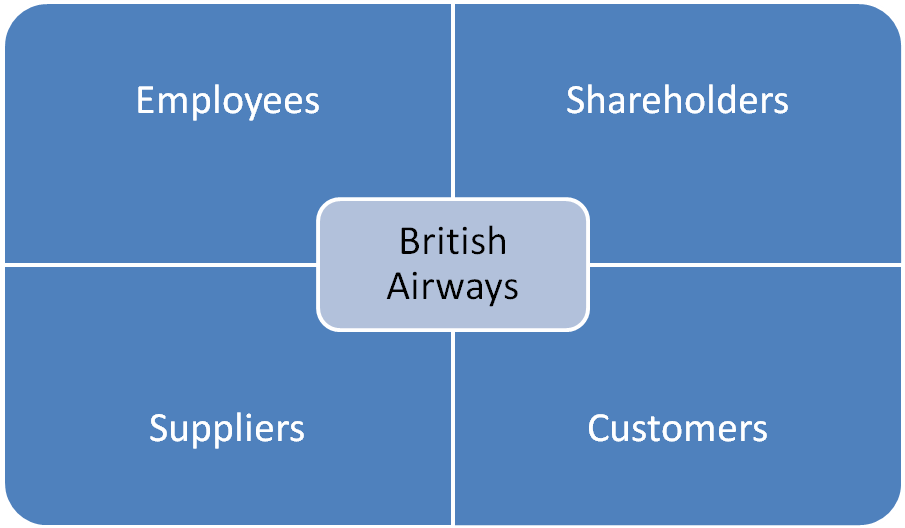Structure and Culture at British Airways
British Airways is governed by six members in the leadership team. These leadership posts include the posts of Commercial Director, Chief Information Officer, Director of Engineering, Director of Investments and Alliances, Director People and Organisational Effectiveness and General Counsel (British Airways). These leaders basically make executive decisions but for the decisions which are not on executive scale, the leaders are supported by 11 directors. Further along the hierarchy the authoritative responsibilities are trickled down and a cross functional team structure is prevalent within the organization with project based work forces.
British Airways fosters a culture of social and corporate responsibility. It attempts to utilize its workforce to create an atmosphere of growth and innovation. Training programmes are frequently conducted so that employees can keep growing in every capacity. Higher management of the organization aims to encourage employee involvement and to create future leaders. Since higher positions in the organization are filled from within the workforce, employees have opportunities to prosper within the organization and to attain higher posts and positions by doing hard work and growing in their intellectual capacity. British Airways offers its employees rewards and benefit packages to provide motivation. Even though the higher management is male dominated the overall workforce is diversified and provides equal job opportunities to male and females. It can be seen that British Airways is a very employee friendly organization and wants for its employees to advance within the organization rather than find better opportunities elsewhere and leave.
Product Portfolio of British Airways
British Airways is the UK’s largest international scheduled airline, and has a large fleet of Boeings at its disposal allowing it to go to 300 destinations worldwide (British Airways). Since British Airways basically helps in the transportation of customers as well as cargo, it needs a diverse fleet of aircrafts. Its fleet contains a total of 245 aircraft which include Boeings, Airbuses and Avro Rjs. Boeings are further diversified into Boeing’s 737s (33), 747s (57), 757s (13), 767s (21) and 777s (42). Its Airbus fleet includes the models Airbus A319s (33), A320s (25) and A321s (11). British Airways has only 10 Avro RJ100s.
The purpose of keeping so many different models is to provide the customers of British Airways with airplanes meeting their customized needs and services. These aircrafts are all operational and are in perfect order thanks to the British Airways engineering branch which caters to the overhauling and other mechanical needs.
To its product portfolio, British Airways has recently had an addition in the shape of Terminal 5 at the London Heathrow Terminal. This terminal would basically function privately for British Airways passengers and would provide services solely to them.
Besides that, the British Airways Engineering department constantly renovates and modifies its aircrafts to offer its customers an experience different from that of any other airline.
Major Stakeholders of British Airways
British Airways stakeholders can be divided into their employees, their shareholders, their suppliers and finally their stakeholders. The key issue related with the employees is that in recent years with the recession, customers have decreased travelling and overall the tourism industry has gone down. This results in flights either being diverted to other more active destinations or simply closing down of routes. With this downsizing and employee elimination becomes ominous. With regards to the shareholders, decreased tourism results in lower profits or increased costs. These decrease the overall profit of the organization and their shares don’t provide them the profit that they desire. Customers are the most flexible as they can choose from any number of competitors in the airline industry and switch their loyalties depending on better services or cheaper rates. Suppliers often want to sell their services to British Airways at higher costs so that they can earn more profits, and during turbulent times this becomes a problem, as the airline does not wish to do excessive spending and suppliers who can offer their services at a lower cost than others jump at the opportunity to set up a contract with the European giant.

SWOT Analysis of British Airways
Strengths of British Airways
- Strong presence in the UK which enables them to tap into european tourism market as well as cater to pretty much all European customers.
- Has substantial assets to maintain its operations smoothly.
- Is employee friendly and also offers customer satisfaction. It is fulfilling the responsibilities of its stakeholders.
Weaknesses of British Airways
- Relatively unknown outside of the UK. Does not hold a commanding position in the global market.
- Currently facing a recessionary period.
Opportunities for British Airways
- Can enter new avenues of service, and offer new destinations.
Threats to British Airways
- Recession may pinch people’s wallets and companies might downgrade their employees travel expenses. So the top quality airlines might lose out on customers.
References
British Airways. (n.d.). Leadership Team. Web.
British Airways. (n.d.). Who We Are. Web.